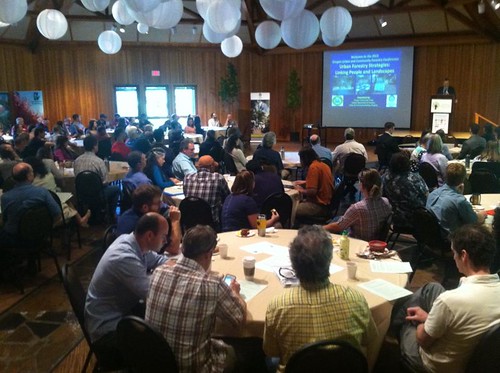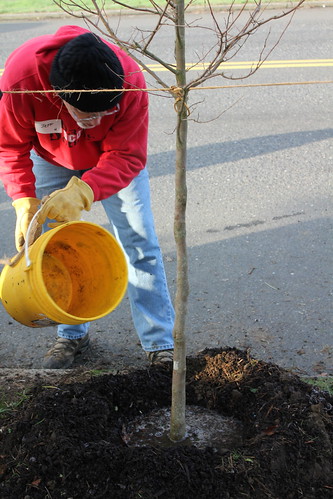Category: Tree City Earth
The Link Between Trees & Human Health is About Life & Death
This year’s Urban & Community Forestry Conference, sponsored by Oregon Community Trees and Oregon Department of Forestry, focused on “Urban Forestry Strategies: Linking People & Landscapes.” Each speaker’s presentation shed light on the connections between trees and human health.

Keynote speaker Dr. Kathy Wolf, Research Social Scientist and Program Director at the USDA Forest Service, University of Washington, noted that a great number of studies have been conducted on the ecosystem benefits that trees provide. These studies show that, by cleaning our air and water, reducing energy use, cooling streams for native fish, reducing erosion and more, trees are far better than people at multi-tasking. They are “the hard workers in the background of our lives.”
An increasing number of recent studies are demonstrating trees’ relationship to human health and well-being. With more funding, the research will soon reveal the causal relationships between the two.
Topics Dr. Wolf touched on included the cognitive and health advantages of saving children from “nature-deficit disorder” and a growing understanding of “attention restoration theory.” In workplaces, for example, just a 15 or 30-minute break spent in nature during a work day increases job satisfaction, reduces employee illness, and enhances people’s ability to focus on their work when they return to the office.Read More
Climate Change & Giant Sequoias

“The world’s largest living species, native to California’s Sierra Nevada, faces a two-pronged risk from declining snowpack and rising temperatures. The threat to sequoias mirrors a growing danger to trees worldwide, with some scientists saying rapid warming this century could wipe out many of the planet’s old trees.
“Few living things seem as permanent as the giant sequoia trees of California’s Sierra Nevada. The largest species of flora or fauna on Earth, these towering redwood trees have held sway for millions of years in a narrow band of their native mountain habitat. With heights reaching 300 feet and girths as large as 150 feet, some sequoias can live in excess of 3,000 years before being naturally toppled by a combination of weather and gravity.
“Although giant sequoias (Sequoiadendron giganteum) have survived previous eras of climate variability, human-caused climate change has so far not been their nemesis. But U.S. government and university researchers say the long-term existence of these trees could be threatened by the vagaries of a changing Sierra Nevada mountain snowpack and global warming. This combination could make it difficult for giant sequoias, particularly seedlings and young trees, to survive because they would be left with insufficient water to endure longer and warmer summers.”
– Posted on Environmental Network News, From: Bruce Dorminey, Yale Environment360, Published March 22, 2013 06:06 AM
Visit FriendsofTrees.org to learn how you can plant trees to slow climate change.
Young trees need water during cold, dry spells

By Kris Day
Do your new tree a favor by giving it a long, slow drink when a cold, dry spell is upon us—especially if it’s evergreen!
Believe it or not, trees can suffer the effects of “drought” even during a Portland winter if their root systems aren’t yet adequate to replace water lost to cold, drying winds.
It’s best to water ahead of windy or freezing weather, but even afterwards can still helpful. Just make sure to apply water when the temperature is above freezing so it doesn’t turn to ice before getting into your tree’s root zone.
–Day is Neighborhood Trees & Green Space Initiative Senior Specialist at Friends of Trees. She is also an ISA Certified Arborist.
The Man Who Planted Trees & other books to start the New Year

Recently The New York Times Book Review featured inspiring new books about trees. At the top of the list? Jim Robbins’ “The Man Who Planted Trees.” According to Robbins, “trees and forests are the highest functioning members of ecological society.”
Below is an exerpt from Dominique Browning’s review:
His [Jim Robbins’] absorbing, eloquent and loving book, THE MAN WHO PLANTED TREES: Lost Groves, Champion Trees, and an Urgent Plan to Save the Planet (Spiegel & Grau, $25), chronicles the adventures of a veritable Noah of the tree world, David Milarch, a Michigan nurseryman who, following a near-death experience, began a quest to locate and save genetic material from some of the oldest and healthiest specimens. Thus the Champion Tree Project was born, with a goal of cloning the champion of each of 826 species of trees in the United States. Not since 1997, when Julia Butterfly Hill climbed a 1,500-year-old redwood and lived in it for two years to spare it from loggers, has one person done more to save trees.Read More
World’s best tree climbers converge on Laurelhurst Park

On a recent Saturday in Portland’s Laurelhurst Park, a photographer snapped pictures of a bride and groom while a bucket ride lifted a family into a towering tree and kids gripped ropes strung from another tree’s limbs. In five stately trees nearby, arborists from 16 countries competed for the world championship in tree climbing.
If they weren’t in a tree themselves, most people in the park gazed up into the trees. Around them rose shouts of encouragement and animated exchanges in Chinese, Italian, Japanese, Dutch, Norwegian, French, Swedish, German, Belgian, Austrian, Danish and English.
